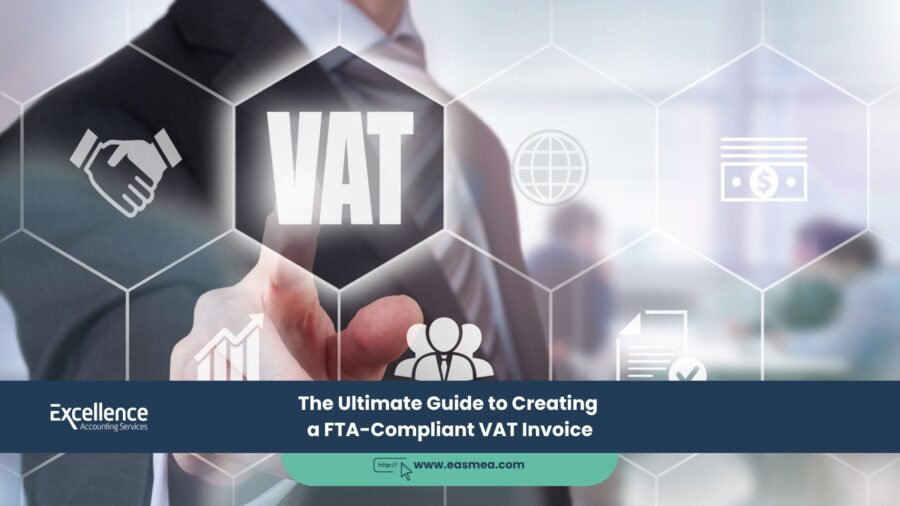The Ultimate Guide to Creating a FTA-Compliant VAT Invoice
In the UAE’s business ecosystem, the introduction of Value Added Tax (VAT) transformed financial operations. For any business registered for VAT, the tax invoice is not just a bill for a customer; it is a critical legal document that forms the backbone of the entire tax system. It is the primary evidence for charging output tax and recovering input tax. An incorrect or non-compliant invoice can lead to disputes with customers, complications in your accounting, and, most importantly, significant penalties from the Federal Tax Authority (FTA).
- The Ultimate Guide to Creating a FTA-Compliant VAT Invoice
- Why is the Tax Invoice So Important?
- The Full Tax Invoice: A Detailed Breakdown
- The Simplified Tax Invoice: For B2C and Smaller Transactions
- Common Mistakes and How to Avoid Them
- Ensure Perfect Invoicing with Excellence Accounting Services (EAS)
- Frequently Asked Questions (FAQs)
- Are Your Invoices 100% Compliant?
Getting the VAT invoice right every single time is non-negotiable. The FTA has laid out specific, mandatory requirements for what constitutes a valid tax invoice. Failing to adhere to these rules is one of the most common and easily avoidable mistakes a business can make. Whether you are issuing an invoice for a multi-million dirham B2B transaction or a small cash sale at a retail outlet, the principles of compliance remain the same.
This guide provides a definitive, step-by-step breakdown of how to create a fully FTA-compliant VAT invoice. We will cover the mandatory components for both full and simplified tax invoices, illustrate them with clear examples, highlight common errors to avoid, and explain the importance of proper record-keeping. Mastering this process is a fundamental step in ensuring your business remains compliant, efficient, and penalty-free.
Key Takeaways
- The Tax Invoice is a Legal Document: It is the cornerstone of VAT compliance, required for every taxable supply made by a registered business.
- Two Types of Invoices: Understand the difference between a “Full Tax Invoice” (for supplies over AED 10,000 or to other VAT-registered recipients) and a “Simplified Tax Invoice” (for B2C sales or supplies under AED 10,000).
- Every Component is Mandatory: Missing even one required field, like the words “Tax Invoice” or the correct exchange rate, can render the invoice non-compliant and lead to penalties.
- Technology is Your Ally: Using FTA-accredited accounting software like Zoho Books automates the creation of compliant invoices, significantly reducing the risk of human error.
- Record Keeping is Crucial: You must retain copies of all tax invoices issued and received for a minimum of five years.
Why is the Tax Invoice So Important?
The tax invoice serves three primary functions in the UAE VAT system:
- For the Seller: It is the legal instrument used to charge and account for the VAT (output tax) collected on behalf of the government.
- For the Buyer: If the buyer is also VAT-registered, the tax invoice is the only document they can use to prove they paid VAT on a purchase and can therefore reclaim it (input tax) on their VAT return. Without a valid tax invoice, they cannot recover the VAT.
- For the FTA: It creates a clear audit trail, allowing the FTA to trace transactions from seller to buyer and verify that the correct amount of tax has been declared and paid.
An invoice without all the mandatory FTA elements is just a piece of paper. A compliant tax invoice is a legal document with financial consequences. The difference is in the details.
The Full Tax Invoice: A Detailed Breakdown
A full tax invoice must be issued in two main scenarios: when the recipient is registered for VAT, or when the total value of the supply is more than AED 10,000. It must contain the following 13 mandatory components.
Example: Full Tax Invoice Components
Let’s break down each required field.
- The words “Tax Invoice” clearly displayed on the invoice.
- Supplier’s Name, Address, and TRN: Your company’s full legal name, address, and your Tax Registration Number (TRN).
- Recipient’s Name, Address, and TRN: Your customer’s full legal name, address, and their TRN (if they are registered).
- A Sequential Invoice Number: A unique, sequential number that identifies the invoice and cannot be repeated.
- Date of Issue: The date the invoice was created.
- Date of Supply: The date the goods or services were delivered (if different from the invoice date).
- Description of Goods or Services: A clear description of what was sold for each line item.
- Unit Price, Quantity, and Rate of Tax for each item: The price per unit (exclusive of VAT), the quantity sold, and the VAT rate applicable to that item (e.g., 5% or 0%).
- Any Discounts Offered: The amount of any discounts applied to any line items.
- Total Amount Payable (excluding VAT): The subtotal before VAT is added.
- Total VAT Amount Payable: The total amount of VAT charged on the invoice.
- Total Amount Payable (including VAT): The final grand total that the customer must pay.
- Exchange Rate (if applicable): If the invoice is issued in a foreign currency, the AED equivalent of the VAT amount must be shown, along with the exchange rate used.
The Simplified Tax Invoice: For B2C and Smaller Transactions
For certain transactions, businesses are permitted to issue a simplified tax invoice, which has fewer mandatory components. This is allowed when:
- The recipient is not registered for VAT (e.g., a retail customer).
- The total value of the supply is AED 10,000 or less.
This is common in retail, restaurants, and other B2C environments. A simplified tax invoice must contain the following 5 components:
- The words “Tax Invoice” clearly displayed.
- Supplier’s Name, Address, and TRN.
- Date of Issue.
- A Description of the Goods or Services.
- The Total Consideration (Total Amount Payable) AND the tax amount included. This is a key difference. Instead of showing subtotals, you must state the final price and explicitly mention the amount of tax that is part of that price. For example: “Total: AED 105 (inclusive of AED 5 VAT)”.
| Requirement | Full Tax Invoice | Simplified Tax Invoice |
|---|---|---|
| Title “Tax Invoice” | ✔ Mandatory | ✔ Mandatory |
| Supplier Name, Address, TRN | ✔ Mandatory | ✔ Mandatory |
| Recipient Name, Address, TRN | ✔ Mandatory | ✖ Not Required |
| Sequential Invoice Number | ✔ Mandatory | ✖ Not Required (but recommended) |
| Date of Issue | ✔ Mandatory | ✔ Mandatory |
| Date of Supply | ✔ Mandatory (if different) | ✖ Not Required |
| Line items with price, quantity, VAT rate | ✔ Mandatory | ✖ Not Required |
| Totals (Subtotal, VAT, Grand Total) | ✔ Mandatory | ✖ Not Required (Only final total) |
| Statement of tax included in total | ✖ Not Required | ✔ Mandatory |
Common Mistakes and How to Avoid Them
Even with clear guidelines, businesses often make simple mistakes that can lead to penalties. Here are the most common errors:
- Missing the Title: Forgetting to clearly state “Tax Invoice” at the top of the document.
- Incorrect TRN: A typo in either your own or your customer’s TRN. Always double-check.
- Mathematical Errors: Incorrectly calculating the VAT amount. This is a common issue with manual invoicing.
- Incorrectly Handling Zero-Rated Supplies: A tax invoice must still be issued for zero-rated supplies (like exports), showing the VAT rate as 0%.
- Failing to Issue a Tax Credit Note: If a customer returns goods or a price is reduced after an invoice is issued, you must issue a “Tax Credit Note” with specific details to correctly adjust the VAT.
Ensure Perfect Invoicing with Excellence Accounting Services (EAS)
Manual invoicing is prone to error. The best way to ensure consistent compliance is through robust systems and expert oversight. EAS provides comprehensive solutions to manage your entire invoicing and VAT process.
Our Services for Flawless Compliance:
- Accounting System Implementation: We specialize in implementing FTA-accredited software like Zoho Books, which automates the creation of compliant tax invoices, eliminating manual errors.
- VAT Return Filing: Our team ensures that the data from your invoices is correctly compiled and used to file accurate VAT returns on time, every time.
- VAT Consultancy and Health Checks: We can review your current invoicing process, identify potential compliance gaps, and provide actionable recommendations to prevent penalties.
- Outsourced Accounting: Let our professional team handle all your bookkeeping and invoicing, giving you peace of mind that your financial records are always accurate and compliant.
Frequently Asked Questions (FAQs)
The FTA can impose a penalty of AED 5,000 for each incorrect tax invoice or tax credit note issued. This can add up very quickly if you have systemic issues in your invoicing process.
No. A tax invoice is only required for taxable supplies (those subject to 5% or 0% VAT). You do not need to issue a tax invoice for supplies that are exempt from VAT, such as certain financial services or the supply of bare land.
Yes, you can. However, if you do, the tax invoice *must* also show the total VAT amount converted to AED, along with the exchange rate approved by the UAE Central Bank that you used for the conversion. This is a mandatory requirement.
A Tax Credit Note is essentially a negative invoice. You must issue one whenever a previously issued tax invoice needs to be reduced. Common scenarios include a customer returning goods, a discount being applied after the sale, or a cancellation of services. The credit note must reference the original invoice and show the reduction in VAT.
Yes. You must issue a tax invoice for every taxable supply you make. In this case, since the customer is not registered, you would issue a Simplified Tax Invoice (assuming the total is AED 10,000 or less). The customer may need it for their own accounting or warranty purposes.
The law requires you to keep records of all tax invoices issued and received for a minimum of five years after the end of the tax period they relate to. For businesses in the real estate sector, the record-keeping period is extended to 15 years.
Yes, you can issue invoices in English or any other language. However, the FTA has the right to request that you provide an Arabic translation of any documents, so it is a good practice to have bilingual templates if you primarily deal with Arabic-speaking customers or government entities.
The “Date of Issue” is the date you create the invoice. The “Date of Supply” is the date the goods were delivered or the service was completed. Often, these are the same date. However, if you deliver goods on the 25th of the month but only issue the invoice on the 1st of the next month, both dates must be clearly shown on the full tax invoice.
For every sale to a UAE customer, you must issue a tax invoice. Since these are typically B2C transactions, a simplified tax invoice is usually sufficient. This should be generated automatically by your e-commerce platform and sent to the customer electronically. It is your responsibility to ensure your platform’s invoice template is FTA-compliant.
The single best way is to use a modern, cloud-based, FTA-accredited accounting software like Zoho Books or Xero. These platforms have built-in, compliant invoice templates. They automate calculations, manage sequential numbering, and make it nearly impossible to create a non-compliant invoice. This removes the risk of manual data entry errors and ensures consistency.
Conclusion: The Foundation of Good Tax Practice
The tax invoice is more than an administrative task; it is a fundamental pillar of your business’s financial integrity and VAT compliance. By understanding the specific requirements set by the FTA and implementing robust processes and systems to meet them, you protect your business from significant financial penalties and build trust with your customers and the authorities.
Treat every invoice with the attention to detail it deserves. By embedding compliance into your daily operations, you ensure that this critical document is always an asset to your business, never a liability.
Are Your Invoices 100% Compliant?
Let Excellence Accounting Services review your invoicing process and help you implement systems that guarantee compliance.




